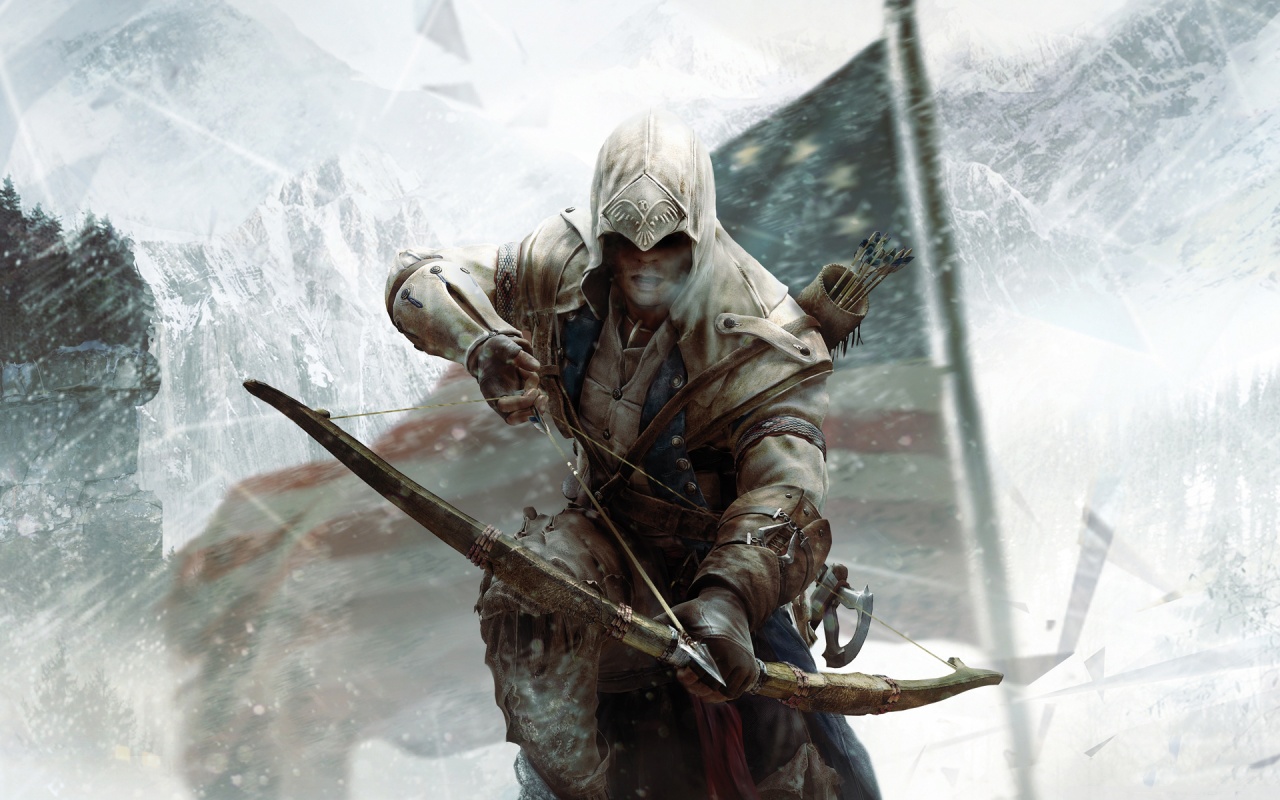Skills
The Skills of Connor Kenway AKA Ratonhnhaké:ton
[notice]Ever wanted to Fight Like Connor/Ratonhnhaké:ton? Now you can, with the Connor Kenway Fighting Style Combat Guide [/notice]
Connor Kenway Quick Navigation Links:
Character Breakdown: Connor Kenway
The Connor Kenway Workout
The Skills of Connor Kenway
The Dichotomy of Connor Kenway
Connor has a large and varied skill set, to try to hit all of his skills at once would be as difficult as it would with Ezio or Altair. We are going to try to hit on some of his more distinctive skills, though. Let’s just dig in!
Fighting with Tomahawk and Knife
Okay, so let me preface by saying I will be filming a tomahawk and knife video game combat video or two this weekend. Yes this is awesome. Take a moment to soak it in and quell your overwhelming excitement before reading on.
The small axe and the knife have actually both been used as weapons and tools by many, many people, tribes, countries, and cultures going back hundreds, if not thousands of years. They are both handy in that they are utilitarian tools AND weapons, in fact, they’re both still being issued by modern combat forces. The utility of the tomahawk is undeniable. It’s relatively intuitive to use, can be just as useful as a close quarters weapon, a camping/survival tool, or a thrown weapons.
Dual wielding these weapons grants a large range of combat options, and a relatively good combat coverage against other hand-to-hand weapons. In Ratonhnhaké:ton’s time, the tomahawk was superior to muskets and rifles in that while the fixed bayonette had larger range, the tomahawk could trap, redirect, and more easily react, in addition to being useable in smaller spaces due to its size.
Similarly, the knife is incredible versatile in CQC(close quarters combat) due to both its speed and versatility. Connor’s knife is a double-edged weapon, that he holds in a reverse grip in open combat, with an additional “spine” on the butt of the knife. This allows for a strong defensive posture, with multiple attacking angles possible.
I’m really excited to do this video(maybe videos) this weekend, so I’m not going to gush too more about these weapons now, but trust me, it’s going to be cool.
Ambidexterity
Dual wielding is incredibly common in the video game world, because it looks flipping cool, however in real life dual wielding weapons is actually very difficult to coordinate, and doesn’t necessarily offer a significant advantage unless you’ve trained for years. Unless you were born ambidextrous, that is, equally dominant with both sides of your body, then you will probably not be able to achieve true ambidexterity ever. That’s okay, though! We want to train complementary ambidexterity here, not competitive. Basically that means we need to teach whatever hand you’re less dominant with to get along nicely and cooperate better with your dominant hand. Here’s some tips!
Learn Juggling
Juggling will help improve gross motor skills with both hands, as well as increase your proprioception. It’s difficult to describe in text how to begin juggling, so here’s an excellent, straightforward video instead!
Three Ball Cascade(basic three ball juggling)
Get a Reaction Ball
Reaction balls are lumpy rubber balls that look almost like dog chew toys. They’re used a lot in sports like baseball to train coordination. I have this one, and I like it a lot. Here’s what you’re going to do: Find a wall, stand a few feet away from it, and gently toss it underhand at an upward angle towards the wall. Here’s the trick: Whichever side of your body the ball bounces to, that’s the hand you have to catch it with. Then you have to throw it again with that hand. No cheating! You can increase difficulty by throwing it at the wall harder, standing closer to the wall, or having a friend stand behind you and throw it at the wall(so you don’t know what side it’s coming from).
Practice Your Drills
Seriously, if we’re training to be ambidextrous with weapons here, the best thing for us to do is actually train with the weapons. I’m going to have some basic drills and movements to practice in the combat video, so practice them. I mean, honestly, practice is the most important thing when learning anything new, dual wielding weaponry is no different.
Tracking
Tracking animals can be entertaining and fun, even if you have no intention of hunting them like Raonhnhaké:ton. This blog serves many different regions, so rather than focus on how to track individual animals that can vary from region to region, we’ll instead look at some basic principles. If you want to know exactly what tracks of animals in your area look like, the internet is a rich resource for that, and by applying the basic principles here, you can find and follow the tracks you want.
Be Patient
Scanning an area multiple times, or from different angles can often reveal things you didn’t see before. Tracking is observation honed to a keen degree, you need to give your eyes and brain time to look at a scene, especially if tracks and signs aren’t immediately apparent.
Use Light to Your Advantage
Keep the sun in front of you, or, if tracking at night, shine your flashlight at a forward facing angle, rather than straight down. This enables you to see shadows cast in tracks that you may normally miss if your own silhouette is blocking the sun, or if your light source is pointing at too straight a downward angle.
Look for Signs Other than Tracks
Animals leave plenty of other signs and clues besides footprints. Scat(poop), markings, broken stems, compressed grass, and chewed vegetation are all great animal signs to tip you off to something being in the area.
Know Your Mediums
Stiff mud(mud that you can sink into that will still hold its shape) is great for tracking footprints in. Loose leaves or pine needles are not. That said, loose leaves and pine needles may reveal an overall trail better than mud or sand would, especially if the animal moves close to the ground. Learn what different ground covers and areas can yield.
Start in Smart Places
If you know there’s a fresh water source in an area, that’s always a good place to start. All animals stop to drink at some point, and fresh mud is a great place to pick up an animal’s tracks(as stated above). Known food sources such as berries, non-toxic foliage, and carrion work as well. Look for things animals will be drawn to.
If you’re interested in going more in-depth into tracking, check out these two sites:
http://www.naturetracking.com/Tracking/NatureTracking.html
The Mohawk Tribe
The Mohawk tribe originally hailed from the region around the Mohawk river in middle and upstate New York. They are one of the founding tribes of the Iroquois League, and as the easternmost tribe they were the “keepers of the eastern door.” Their true tribal name is the Kanien’kehake, or “people of the flint,” due to the large amount of flint found in the valleys and mountains where they lived.
The Kanien’kehake were a powerful tribe in their time, contesting and controlling a large region, as well as dominating the furs trade with the native Dutch in the 1600s. They had a tumultuous relationship with both the French, in Canada, the British, in New England, and finally the American colonies. At the time of the revolutionary war, most of the Kanien’kehake actually fought for the British, however there was also a contingent that chose to serve under Washington’s command in the Continental Army.
The Kanien’kehake that fought for the British did so under the assumption that the Americans would run them off their land. Unfortunately, this turned out to be true, and there was great conflict among the Kanien’kehake and the Americans because of it, as well as conflict within the tribe itself. The Kanien’kehake now live mainly in four reservations, two in New York, and two in Canada.
The Kanien’kehake have an additional claim to fame in that they were extremely instrumental in constructing the original skyscrapers of New York city. Mohawk workers were prized in their ability to be fearless and surefooted at any height(sound like someone we know), and even today there’s a contingent of five-hundred or so Kanien’kehake workers that still commute down to work on skyscrapers during the week, and then drive back up to spend time with their families on the weekends.
A proud, resilient, and strong people, the Kanien’kehake have endured conflicts that have wiped out or assimilated other tribes, and have managed to preserve a good portion of their original way of life, even with the hardships they’ve endured. Learning about their culture for this week was fascinating, and I really enjoyed it.
That’s all for today. Sorry it’s up a bit later in the afternoon than we’re used to, a lot of research when into this one. I hope you enjoyed it! Tomorrow we finish up with The Dichotomy of Connor Kenway! Please don’t forget to like the blog on Facebook, and follow on Twitter and Tumblr. While you’re at it, if you enjoyed this post, please share/retweet it to your friends! Until then, remember to live boldly, change the world, and continue to be awesome.
Dan “DaRatmastah” Wallace





Pingback: Character Breakdown: Connor Kenway AKA Ratonhnhaké:ton » Be a Game Character
Pingback: The Connor Kenway Workout » Be a Game Character
Pingback: The Dichotomy of Connor Kenway AKA Ratonhnhaké:ton » Be a Game Character
LOve connor.. U got a nice webpage about him.. I got a video tribute for him. 🙂